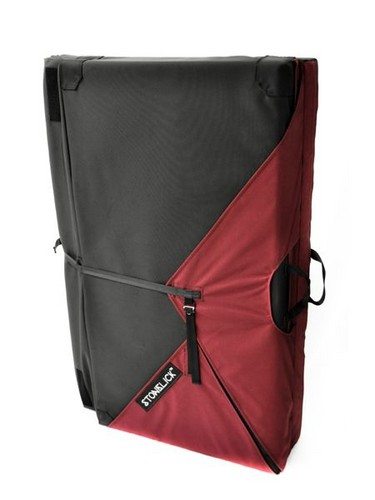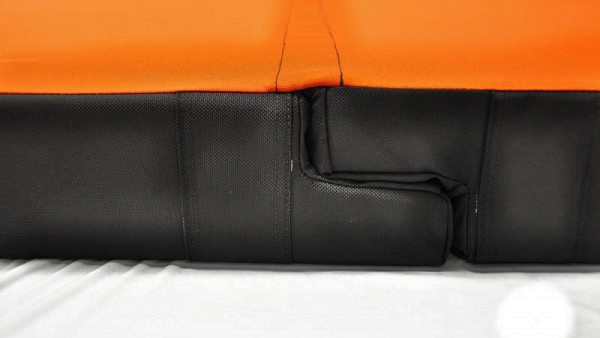
Stonelick Gordita Bouldering Pad
Dimensions:
48” x 59” x 4.5”
(122cm x 150cm x 11.5cm)
Foam Layers:
- Impact Layer: 1” Closed-cell PE foam
- Middle Layer: 3” PU foam
- Bottom Layer: 0.5” Closed-cell PE foam
Cover Material:
- 1000D Coated Cordura landing surface
- 1050D Ballistic cover with reinforced corners and hinge
Features:
- Padded Waist Belt and Shoulder Straps
- Sternum Strap
- Adjustable Flap Closure
- “Step-Hinge” Technology
Weight: 21.4 lbs.
MSRP: $385
Days Tested: 75+
Test Locations: Bolton and Smuggler’s Notch, Vermont; South Platte, Colorado; Moe’s Valley, Utah; Red Rocks, Nevada
When solo or highball bouldering, confidence in the pad beneath you is everything. If you aren’t confident that your pad can protect you from rocks and roots in a fall, then you won’t be able to focus solely on climbing.
With taller and bolder ascents being put up every year, it’s only natural that crash pads have gotten bigger and thicker, and most companies now have a larger “highball” pad in their lineup.
Stonelick is a relatively new, small company based out of Bennington, Vermont. As a native Vermonter, I was naturally interested in the prospect of a local company, plus Stonelick is putting out products with new, innovative designs. All of Stonelick’s crash pads feature a smart looking “step-hinge” design, which I’ll say more about below.
I was looking for a large pad for highball problems, but also, since I enjoy bouldering alone, I wanted a single pad that could cover a large area. The Stonelick Gordita seemed like it could fit the bill, and I was curious to see how is stacked up to pads like the Black Diamond Mondo and Organic Big Pad.
Step-Hinge Design
As I mentioned above, the feature that really sets the Gordita apart from comparable pads is the step-hinge design. Most bouldering pads use a hybrid or taco hinge, both of which present problems. A taco hinge is exactly what it sounds like: the pad is made of a single piece of foam that is bent and folded over on itself (like a taco) when closed. This weakens the foam at the crease, where the pad is folded over repeatedly. A hybrid hinge design, which is what you’ll find on the Mondo and Big Pad, uses two layers of foam to form the hinge: a thinner sheet of closed-cell foam that covers the pad’s entire footprint, layered over two separate open-cell sections of thicker foam (that make up each half of the pad). This design allows the pad to fold over on itself while stressing less of the foam at the hinge, but it still folds and weakens the top layer of foam.
Stonelick looked to create a way to eliminate the durability problems associated with these hinge designs, so they came up with the step-hinge made up of two interlocking “steps” that make up the hinge of the pad. This design is supposed to make the hinge more durable (as no foam is bent or compressed when the pad is folded over on itself), and it said to eliminate dead spots along the pad’s hinge (so it offers just as much cushioning as any other part of the pad—not the case with a hybrid- or taco-style hinge).

Hip Belt & Shoulder Straps
Like most other large bouldering pads, the Gordita includes a fully padded hip belt and shoulder straps, which make even the longest and heaviest approaches relatively comfortable. Unlike those of Organic or Black Diamond, the harness system for this pad is not contoured, which has its pros and cons. What I like about the harness is that I find it to be more comfortable than the contoured harness on long approaches, as it is better cushioned and sits more comfortably. I’ve found that, while contoured straps are stiffer and curved to fit the shape the users shoulders, if they don’t fit your frame / body type quite right, they can dig into your shoulders and neck. I have found this to be particularly true of Organic’s harness systems, but I haven’t had this problem at all with the Gordita’s non-contoured harness system.

The downside of the non-contoured design is that the straps aren’t quite as durable or supportive as contoured straps. If the pad is loaded down with a lot of gear, it tends to sag a bit more due to the softness of the straps, making it more awkward and top-heavy when you’re carrying it. This is the benefit of Organic’s style harness if it fits you well — it may fit more like a nice backpack, and the weight of the pad is may be better supported.
Closure System
The closure system is another great feature of the Gordita, and it is found on all Stonelick pads. It is comprised of two large flaps attached to each side of the pad that wrap around it and are secured with quick-clips. These flaps can be a bit cumbersome to deal with compared to the simple straps on the Mondo or Big Pad, as it can take some work to get the flaps wrapped snugly around the sides of the pad and clipped in. Once secured, however, the closure flaps do their job very well, and I almost never lose gear out of the bottom of the pad while on long approaches.
Another nice feature of the Gordita that is surprisingly non-existent on other large pads is a handle at the top of the pad’s shoulder straps. It’s nothing special, but this strap makes getting the fully packed pad onto your back way easier.
